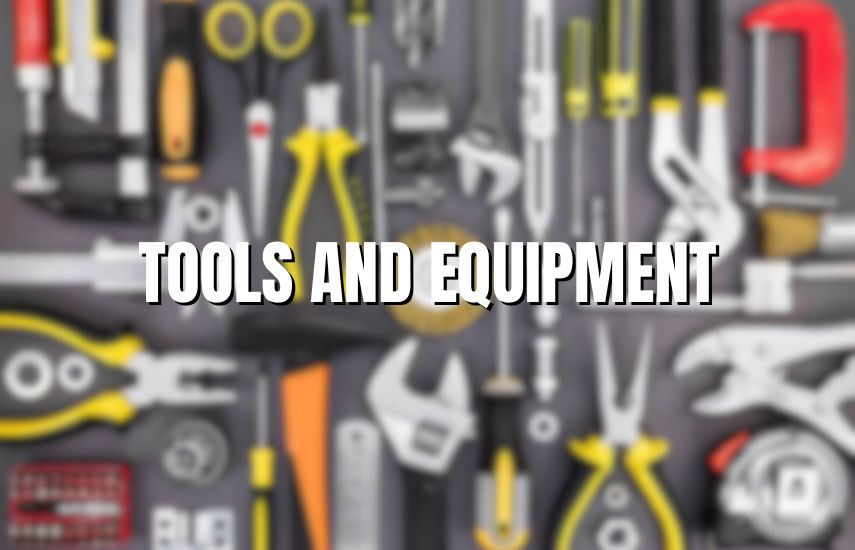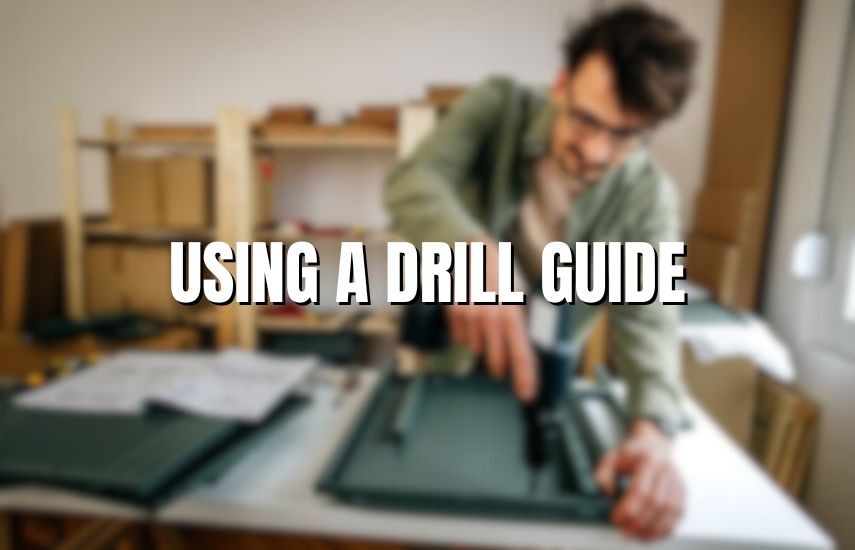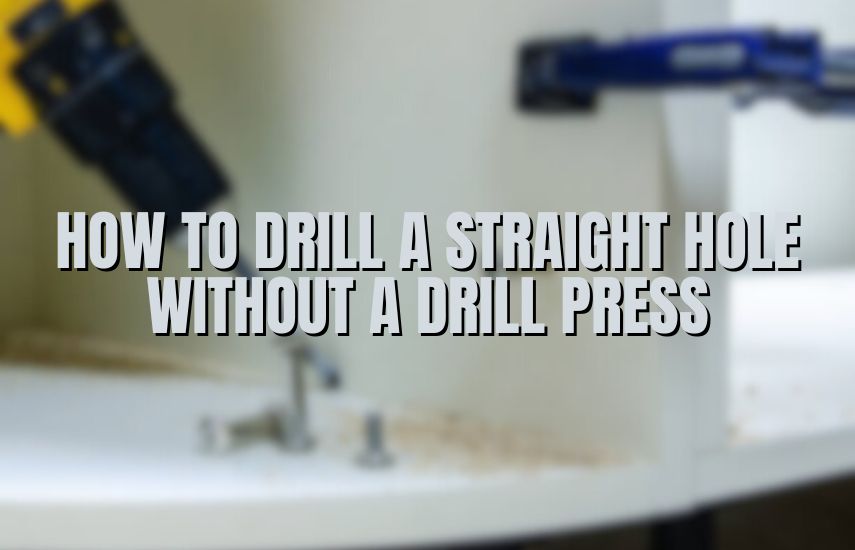Do you ever find yourself in a situation where you need to drill a straight hole but need a drill press handy? You may be working on a DIY project at home or out in the field and don’t have access to all the tools you need. Whatever the reason, drilling a straight hole without a drill press can be a challenging task.
How To Drill A Straight Hole Without A Drill Press? To drill a straight hole without a drill press, start by marking the spot where you want the hole. Then, use a centre punch to create a small divot for the drill bit to rest in. Next, use a hand drill and apply steady pressure as you drill. Keep the drill perpendicular to the surface you’re drilling into.
But fear not because you can consistently achieve a precise and straight hole with the proper techniques and tools. In this blog, we’ll explore some creative and unique ways to accomplish this feat so you can confidently get back to your project.
Understanding Drill Press Alternatives
While a drill press can make drilling precise and straight holes easier, not everyone can access one. Fortunately, several alternatives can be used to achieve the same result.
Handheld Power Drills
Handheld power drills are a versatile tool that can be used for a wide range of drilling tasks, including drilling straight holes. Here are a few tips to help you drill straight holes with a handheld power drill:
- Mark the spot: Before drilling, mark where you want to drill your hole. This will help you guide the drill bit and keep it on track.
- Use a level: To ensure that you are drilling straight, use a group to check that the drill is level before drilling.
- Start slowly: Start drilling at a slow speed to ensure that you have control over the drill. You can increase the speed as you get comfortable with the drilling process.
- Apply steady pressure: Apply continuous pressure to the drill while drilling to keep it on track. Avoid putting too much pressure, which can cause the drill bit to bend or break.
- Use a drill bit guide: A drill bit guide can help keep the drill bit straight and prevent it from wandering off course. You can purchase a guide or make one by attaching a straight edge to the surface where you want to drill.
Drill Guides
A drill guide is a tool that can be used to help guide the drill bit and keep it on track. Here are some tips on using a drill guide:
- Choose the right guide: Different types of drill guides are available, including portable guides and fixed guides. Choose the direction that is best suited to your needs.
- Mark the spot: Before drilling, mark where you want to drill your hole. This will help you guide the drill bit and keep it on track.
- Secure the guide: Make sure the guide is securely in place before you start drilling.
- Use the correct drill bit: Use the right size and type for the job.
- Start slowly: Start drilling at a slow speed to ensure that you have control over the drill. You can increase the speed as you get comfortable with the drilling process.
Tools and Equipment

Having the right tools and equipment is crucial when drilling a straight hole without a drill press.
Also, check How To Drill Ceramic Tile.
Choosing the Right Drill Bit
Choosing the right drill bit is essential for drilling a straight hole. The drill bit you choose should match the material you are drilling and the hole size you need.
For example, you will want to use a wood drill bit if drilling into wood. These bits have a sharp point and a fluted design that allows for the efficient removal of wood chips. If you are drilling into metal, you will need a metal drill bit that can withstand the hardness of the material.
It’s also important to consider the size of the hole you need. Using a drill bit that is too small or too large can result in an uneven spot. Make sure to measure the size of the hole you need accurately before selecting a drill bit.
Measuring Tools and Marking Techniques
Measuring tools and marking techniques are essential for drilling a straight hole without a drill press. A simple way to measure the depth of your hole is to wrap a piece of tape around your drill bit at the desired depth. This will act as a guide and ensure that you drill to the correct depth.
You can use a pencil or a centre punch to mark the spot where you need to drill. A centre punch creates a slight indentation in the material, which will act as a guide for your drill bit. A centre punch is essential to prevent your drill bit from wandering if drilling into metal.
Clamps and Vices for Stability
Clamps and vices can help you stabilize your material and prevent it from moving while you drill. This is particularly important when drilling into metal or other hard materials.
You can use a bench vice to hold your material while drilling. Securely position your material in the vice, ensuring it is level and stable. You can also use clamps to secure your material to a workbench or table.
Drilling a Straight Hole with a Handheld Power Drill
With the right tools and techniques, you can quickly drill a straight hole with a handheld power drill.
Measuring and marking the drilling location
The first step in drilling a straight hole is to measure and mark the drilling location. Use a measuring tape or ruler to measure the distance from the workpiece’s edge to the hole’s centre. Once you have determined the area, use a centre punch to mark the spot where you will drill. This will prevent the drill bit from wandering off course and ensure you drill the hole in the correct location.
Aligning the drill bit perpendicular to the surface
To drill a straight hole, it is crucial to align the drill bit perpendicular to the surface of the workpiece. Use a carpenter’s square or a level to check the alignment of the drill bit. Adjust the angle of the drill until it is perfectly perpendicular to the surface of the workpiece. This will ensure that the hole is drilled straight and true.
Securing the workpiece
Securing the workpiece is essential to ensure it does not move or shift during drilling. Use clamps or a vice to hold the workpiece securely in place. This will prevent the workpiece from moving while you are drilling and ensure that the hole is drilled in the correct location.
Starting the hole and maintaining alignment
Once you have secured the workpiece, start the hole by applying gentle pressure to the drill. As you drill, maintain the alignment of the drill bit by keeping it perpendicular to the surface of the workpiece. Use a steady hand and apply consistent pressure to the drill. This will prevent the drill bit from wandering off course and ensure the hole is drilled straight and true.
Drilling and checking alignment periodically
As you drill the hole, periodically stop and check the alignment of the drill bit. Use a level or carpenter’s square to ensure that the drill bit is still perpendicular to the surface of the workpiece. If necessary, adjust the angle of the drill to maintain alignment. Continue drilling until you have drilled the hole to the desired depth. Once the hole is drilled, remove the drill and inspect the hole to ensure that it is straight and true.
Using a Drill Guide

A drill guide is a great way to drill straight holes without a drill press. It can be beneficial when you need to make precise holes in a material that is too large or irregularly shaped to fit in a drill press.
Selecting the Appropriate Drill Guide
The first step in using a drill guide is to select the appropriate one for the job. Different types of drill guides are available, including those made from plastic, metal, and even wood. It would be best to choose a drill guide appropriate for the size of the drill bit and the material you will be drilling into.
Setting Up the Drill Guide
Once you have chosen the appropriate drill guide, the next step is to set it up. Start by clamping the material you will be drilling into a workbench or a table. Place the drill guide on top of the material in the desired location for the hole. Ensure the guide is stable and will not move during the drilling process.
Aligning the Drill Bit with the Guide
Before drilling the hole, aligning the drill bit with the guide is essential. Place the drill bit into the guide, ensuring it is perpendicular to the material you will drill into. Once you are satisfied that the drill bit is aligned correctly, tighten it into place.
Drilling the Hole
Now that everything is set up and aligned, it is time to start drilling. Turn on the drill and slowly apply pressure to the drill bit. Keep the drill steady and straight as you begin drilling into the material. Take your time and make sure that you are drilling at a consistent speed. Once you have drilled through the material, remove the drill bit and the drill guide.
Tips for Drilling Straight Holes

Drilling a straight hole without a drill press can be challenging but possible with the proper technique and tools. One of the most important aspects of drilling straight holes is adequate control over the drill.
Drilling pilot holes
Drilling a pilot hole is a simple but effective technique that can help you drill straight holes without a drill press. A pilot hole is a small hole you drill before the actual hole. It helps to guide the drill bit and prevents it from wandering off course.
To drill a pilot hole, you will need a drill bit smaller than the hole you want to drill. Start by marking the centre of the hole on the surface you want to drill. Then, the more minor drill bit is used to drill a pilot hole at the marked centre. Once the pilot hole is drilled, switch to the more significant drill bit and drill the hole.
Using the right speed and pressure
Using the right speed and pressure is critical for drilling straight holes without a drill press. When drilling a hole, apply light pressure and gradually increase it as you drill. This will help to keep the drill bit centred and prevent it from wandering off course.
Make sure to use the correct speed for the material you are drilling. For example, hardwood requires a slower speed than softwood or metal.
Conclusion
Need a drill press? No problem! To drill a straight hole, first mark where you want it. Then, use a centre punch to make a small indentation. Use a hand drill and drill slowly, keeping the bit perpendicular to the surface. Keep a steady hand, and you’ll have a straight hole soon!
Drilling straight holes without a drill press is not impossible, but it does require some skill and patience. Throughout this article, we’ve explored several methods for achieving accuracy and precision when drilling holes by hand. Each method has advantages and disadvantages, and it’s up to you to decide which works best for your needs.
Whether you’re a professional woodworker or a DIY enthusiast, accuracy and precision are essential when drilling holes. Even the most minor deviation from a straight line can significantly impact your finished product’s overall quality and functionality. You’ll achieve the accuracy and precision necessary to create high-quality woodworking projects without needing a drill press by mastering the techniques outlined.
Remember, practice makes perfect, so don’t be discouraged if you don’t get it right on your first try. With time and patience, you’ll be able to master the art of drilling straight holes by hand and create beautiful, precise woodworking projects that you can be proud of.
FREQUENTLY ASKED (How To Drill A Straight Hole Without A Drill Press)
How do you drill a straight hole by hand?
To drill a straight hole by hand, start by marking the hole’s location using a centre punch or awl. Next, use a drill bit that matches the size of the desired hole and attach it to a hand drill.
Begin drilling slowly, using firm, even pressure to keep the bit from wandering. Keep the drill perpendicular to the surface, and use a straight edge or guide to help keep it straight. Make sure to periodically clear the hole of debris to ensure a smooth drilling process.
What can I use instead of a drill press?
If you don’t have a drill press, several alternatives can be used to accomplish similar tasks. A handheld power drill is the most common and versatile substitute for a drill press. Using jigs and guides, such as a drill guide or a homemade guide made from scrap wood, can provide the precision needed for many drilling applications.
Another option is to use a rotary tool, which can be fitted with drill bits and used in tight spaces where a giant drill press won’t fit. Finally, a brace and bit, a traditional hand tool, can be used to drill holes in wood and other soft materials, although it requires some practice and patience.
How do you drill a large hole without a drill press?
Drilling large holes without a drill press can be challenging but possible with the right tools and techniques. One approach is to use a spade bit, or hole saw attached to a handheld power drill. Please make a small pilot hole first, then enlarge it gradually with the more significant bit or saw.
Another option is to use a brace and bit, a traditional hand tool consisting of a crank handle and a bit. The brace and bit can be slower than a power drill, but it allows for greater control and precision when drilling large holes.









